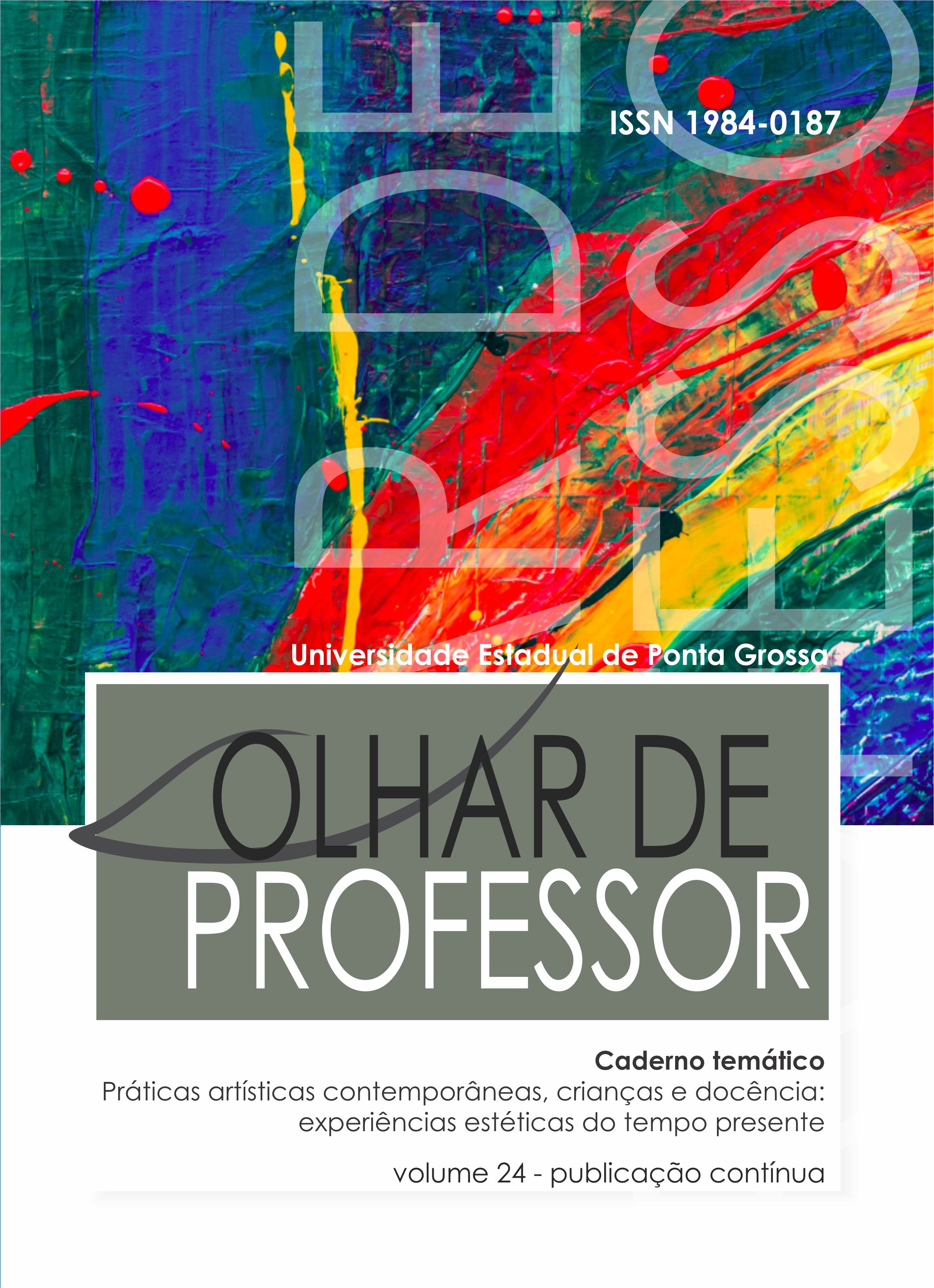Narratives and poetic memories in early Childhood Education: possibilities for teaching Narratives and poetic memories in Early Childhood Education - possibilities for teaching.
Main Article Content
Abstract
This experience report proposes to reflect on an experience developed in Early Childhood Education with young children involving Expressive Languages. The proposal considered the narratives and playful and cultural experiences of children and their grandparents. Their knowledge, practices and cultural values are considered formative knowledge that enrich the repertoires of children and adults, transcend a predicted curriculum and promote a new perspective on teaching. The word artesania dialogues with the text’s propositions in the sense that doing is thinking. Thus, authors like Sennett (2013; 2020); Gobbato;Barbosa (2019); Formosinho (2019), Rinaldi (2012) and others help us to learn in company. Potent listening enhanced the narratives and memories of the subjects involved when building networks of meanings and poetic possibilities for teaching and the process of learning and child development.
Downloads
Article Details
Authors who publish in this journal agree with the following terms:
a) Authors keep the copyrights and concede the right of its first publication to the magazine. The work piece must be simultaneously licensed on the Creative Commons Attribution License which allows the paper sharing, and preserves both the author identity and the right of first publication to this magazine.
b) Authors are authorized to assume additional contracts separately, to not-exclusively distribution of the paper version published in this magazine (e.g.: publish in institutional repository or as a book chapter), with the author identity recognition and its first publication in this magazine.
c) Authors are permitted and stimulated to publish and distribute their papers online (e.g.: in institutional repository or on their personal webpage), considering it can generate productive alterations, as well as increase the impact and the quotations of the published paper.
d) This journal provides public access to all its content, as this allows a greater visibility and reach of published articles and reviews. For more information on this approach, visit the Public Knowledge Project, a project that developed this system to improve the academic and public quality of the research, distributing OJS as well as other software to support the publication system of public access to academic sources.
e) The names and e-mail addresses on this site will be used exclusively for the purposes of the journal and are not available for other purposes.

This work is licensed under a Creative Commons Attribution 4.0 International License.
References
BARBOSA. M. C. S. Práticas cotidianas na educação infantil - bases para a reflexão sobre as orientações curriculares. Disponível: -http://portal.mec.gov.br/dmdocuments/relat_seb_praticas_cotidianas.pdf. Acesso 28042020.
_______. A BNCC e os direitos das crianças: Educação Infantil em evidência. Disponível: http://www.periodicos.se.df.gov.br/index.php/comcenso/article/view/452/271 . Acesso: 22122019.
BRASIL. Resolução CNE/CEB nº 5, de 17 de dezembro de 2009. Disponível em: file:///C:/Users/CAMILA/Downloads/diretrizescurriculares_2012%20(1).pdf. Acesso em 20042020.
BRASIL. Parecer CNE/CEB 20/2009, de 11/11/2009. Disponível em: http://portal.mec.gov.br/index.php?option=com_content&id=12745&Itemid=866. Acesso em 20042020.
BRASIL.. Ministério da Educação. BASE NACIONAL COMUM CURRICULAR (BNCC). A Educação Infantil na Base Nacional Comum Curricular. Disponível: http://basenacionalcomum.mec.gov.br/abase/#infantil. Acesso:20022020.
BRASIL. Ministério da Educação. Lei nº. 9394/96, de 20 de dezembro de 1996. Lei de Diretrizes e Bases da Educação Nacional /LDB. Disponível: http://www.planalto.gov.br/ccivil_03/leis/l9394.htm. Acesso: 01062020.
FORMOSINHO, Júlia Oliveira. Pedagogia-em-Participação: a documentação pedagógica no âmago da instituição dos direitos da criança no cotidiano. Revista Em Aberto v. 1, n. 1, (nov. 1981- ). – Brasília: O Instituto, 1981- . Irregular. Irregular até 1985. Bimestral 198. Disponível: file:///D:/Backup_11042020/Paulo_FOCHI/Pedagogia%20do%20Cotidiano%20na%20(e%20da)%20Educação%20Infantil.pdf . Acesso 25042020.
GOBBATO, C.; BARBOSA, M. C. S. A artesanía, o diálogo e a cooperação: uma perspectiva para a didática na educação infantil. Revista Poiesis. Universidade do Sul de Santa Catarina, vol. 13, n. 24 (2019). Disponível: http://portaldeperiodicos.unisul.br/index.php/Poiesis/article/view/8254/4633 . Acesso 20042020.
HOLM, A. M. ECO ARTE COM CRIANÇAS. 1997. REEDIÇÃO ATELIE CARAMBOLA.2017.
KUHN, Roselaine; CUNHA, António Camilo; COSTA, Andrize Ramires. Sem tempo para brincar: as crianças, os adultos e a tirania dos relógios. Revista Kinesis, 33 ed. vol 1, jan-jul de 2015, Santa Maria.
OSTETTO, L. E. Para encantar, é preciso encantar-se: danças circulares na formação de professores. 2010 Disponível: https://www.scielo.br/pdf/ccedes/v30n80/v30n80a04.pdf . Acesso 20012021.
OSTETTO, L. Arte e formação de professores: autoria e transgressão. 7ed. Campinas, SP: Papirus, 2012.
PIORSKY, G. Brinquedos do chão: a natureza, o imaginário e o brincar. São Paulo – Peiropolis, 2016.
RINALDI, C. Diálogos com Reggio Emília: escutar, investigar e aprender. Tradução de Vania Cury. 5 ed. Rio de Janeiro/São Paulo: Paz e Terra, 2017.
SENNETT, R. Artesanía, tecnologia y nuevas formas de trabajo. Barcelona: Katz CCCB, 2013. ______________. O artífice. 2. ed. Rio de Janeiro/São Paulo: Record, 2020.





